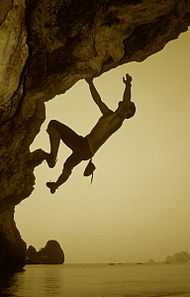Solo climbing
| Part of a series on |
| Climbing |
|---|
 |
| Background |
| Types |
| Lists |
| Terms |
| Gear |
| Climbing companies |
Solo climbing or soloing is a style of climbing in which the climber climbs alone, without somebody belaying them.[1] There are several ways to climb solo. The first is roped solo climbing, which is climbing by yourself with a rope backup in case of fall. Roped soloing is especially useful in rescue situations.[2] There are two ways to rope solo: lead solo and top rope solo. In lead soloing, the climber uses a self-locking device which is used to arrest a fall. One end of the rope may be anchored below the climber with the coils of rope in a bag on the climber's back, or for single-pitch climbs the device may be secured at ground level, and the climber tied into the end of the rope. In top rope soloing, the climber uses a self-locking device and climbs as if top roping. If weight is put on the rope during the climb, it is a form of aid climbing. Perhaps the best known solo technique is Free solo climbing (Known in the UK as soloing), where the climber is climbing without any rope or other forms of protection where a fall would result in serious injury or death.[3] Finally Deep-water soloing, or psicobloc, is a subtype of free solo climbing. It is done on cliffs overhanging water so that in case of a fall, the climber lands safely in the sea.[4]
References
- ↑ Long, John; Sponholz, Hai-Van K. (1999). The High Lonesome: Epic Solo Climbing Stories. Adventure Series: Falcon guide. Globe Pequot. p. 1. ISBN 9781560448587.
- ↑ Tyson, Andy; Loomis, Molly (2006). Climbing Self-rescue: Improvising Solutions for Serious Situations. Mountaineers Outdoor Expert Series. The Mountaineers Books. p. 120. ISBN 9781594851582.
- ↑ Allhoff, Fritz; Florine, Hans (2011). Schmid, Stephen E., ed. Climbing—Philosophy for Everyone: Because It's There. Philosophy for Everyone 37. John Wiley & Sons. p. 160. ISBN 9781444341461.
- ↑ Paul Mason (2010). Rock Climbing: The World's Hottest Climbing Locations and Techniques. Passport to World Sports Series. Capstone. p. 26. ISBN 9781429655002.